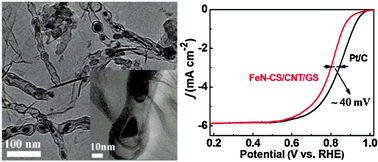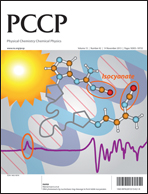Synergistic increase of oxygen reduction favourable Fe–N coordination structures in a ternary hybrid of carbon nanospheres/carbon nanotubes/graphene sheets†
Abstract
A Fe/N co-doped ternary nanocarbon hybrid, with uniform bamboo-like carbon nanotubes (CNTs) in situ grown on/between the single/few-layer graphene sheets interspaced by carbon nanosphere aggregates, was prepared through a one-pot heat treatment of a precursor mixture containing graphene oxide, Vulcan XC-72 carbon nanospheres, nitrogen rich melamine and small amounts of Fe ions. Physical characterization including electron microscopic images, N2 adsorption–desorption isotherms, pore size distribution, XPS, XRD, Mössbauer spectra, and EDX revealed that the 0-D/1-D/2-D ternary hybrid architecture not only offered an optimized morphology for high dispersion of each nanocarbon moiety, while the carbon nanosphere interspaced graphene sheets have provided a platform for efficient reaction between Fe ions and melamine molecules, resulting in uniform nucleation and growth of CNTs and formation of high density Fe–N coordination assemblies that have been believed to be the active centers for the oxygen reduction reaction (ORR) in carbon-based nonprecious metal electrocatalysts. In the absence of graphene oxides or carbon nanospheres, a similar heat treatment was found to result in large amounts of elemental Fe and Fe carbides and entangled CNTs with wide diameter distributions. As a result, the ternary Fe/N-doped nanocarbon hybrid exhibits ORR activity much higher than the Fe–N doped single or binary nanocarbon materials prepared under similar heat treatment conditions, and approaching that of the state-of-the-art carbon-supported platinum catalyst (Pt/C) in acidic media, as well as superior stability and methanol tolerance to Pt/C.


 Please wait while we load your content...
Please wait while we load your content...